Lal Lal Blast Furnace
The Lal Lal blast furnace ruins rate as one of the most important and highly significant sites of early industrial history in Australia. The blast furnace is the only one from the nineteenth century remaining in the Southern Hemisphere and it represents the only attempt to smelt iron ore in Victoria. It has an ‘A’ classification from the National Trust.
The Lal Lal Iron Mining Company was formed in 1874. It set up an iron ore quarry and smelting works, which at its peak employed 160 men. Charcoal from local timber, brown coal from the area and Ballarat coke were all used as fuel for the smelting process. The mine reached its peak in 1884 when 1,600 tons of ore were smelted and 800 tons of pig iron were produced, however production rapidly declined after a few years.
The Lal Lal blast furnace and iron mine are on Iron Mine Rd, at Lal Lal, near the spillway of the Bungal Dam. The ruins of the 17-metre-high furnace and the adjacent iron mine are clearly visible in the bush and information boards explain the operations of this amazing relic of early Victorian industry.

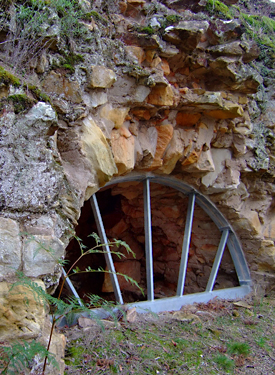
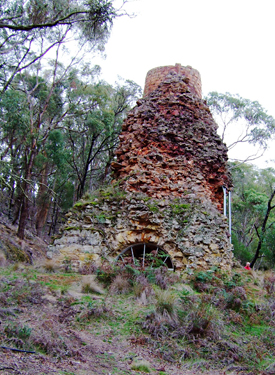
Links for more information
Parks Victoria - Lal Lal Blast Furnace
- Details
Old Sandstone Police Court House
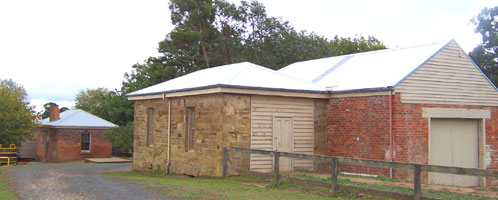
Old sandstone Police Court House in foreground with the Butter Factory's 1893 brick
extension and the original Police Station at rear
Three buildings once stood on this early administrative site in Cornish Street Buninyong: a Police Station, a Warden's Office, and a Police Court House. It is most probable that the sandstone building was the early Police Court House.
Timeline
| 1850's | Early Police Camp set up on this site to administer the Goldfields (previously administered at Chepstowe) |
| 1853 | County Court of Buninyong & Ballarat listed. |
| 1858 | Police Court and Warden's Office built of sandstone. |
| 1859 | Red brick Police Station built. |
| 1888 | The old sandstone Court House was abandoned when the new Town Hall and Court House in Learmonth Street were completed (foundation stone laid in 1886). |
| 1889 | The Borough Council assumed control of the site and the Police Paddock was relocated to between Scott and Yuille Streets (which in turn was sold at public auction in 1991) |
| 1892 | The Borough Council leased the property to the Buninyong Butter Factory |
| 1893 | It was found necessary to enlarge the factory in the Old Court House and Mr Richard Rennie was engaged to build a brick extension at the Butter Factory's expense |
| 1908 | The company decided to erect a new factory nearer to the railway line |
| 1915 | The Buninyong Borough Council recorded its intention to demolish the Eastern end of the Court House and use the materials to lessen the cost of building a lean-to supper room at the rear end of the Town Hall building |
| 1920 | The Court House site was used as a Council Depot |
| 1980's | Negotiations take place to have part of the Court House site combined into the Botanic Gardens and the open ground to the south annexed into the School Oval |
| 1990 | Council relocates the Depot and the buildings are vacated |
| 1992 | Restoration of the derelict historic Court House begins under the direction of the Buninyong & District historical Society |
| 1995 | Official opening of the restored buildings |
Information on the history of Old Stone Court House was supplied by by Beth Ritchie and Derick Leather, Buninyong & District Historical Society.
- Details
Buninyong Cemetery and Old Cemetery
Unusually for a town its size, Buninyong has two cemeteries: the "Old Burial Ground" and the Buninyong Cemetery.
The Buninyong and District Historical Society has published an informative booklet documenting both cemeteries which is available for sale for $3.00 from the Buninyong Information Centre and the Historical Society.
Ballarat City Council now manages the Old Burial Ground with the adjoining reserve Desoza Park. A Cemetery Trust manages the Cemetery.
The Old Burial Ground
Buninyong's Old Burial Ground is a narrow strip of land running between Learmonth St and the Union Jack Creek, near Cathcart St. Early settlers from the 1840's and one aboriginal person are known to be buried here but unfortunately their graves are not marked and their precise locations are no longer known. A Bunya Bunya pine was planted by the CWA in 1988 with a commemorative plaque to mark the approximate position of Buninyong's first graves. The historic burying ground was abandoned in the 1850's when the current cemetery was established further west on the outskirts of the town.
Buninyong Cemetery
The Buninyong Cemetery lies in well-tended grounds west of the township with distant views of Mount Buninyong. The graves of many of Buninyong's founders can be found in this tranquil setting and and it is still used today.
A complete set of the Cemetery's burial records can be searched in the Buninyong Information Centre.
Buninyong Cemetery Trust
The Buninyong Cemetery is managed by a Board of Trustees which has is responsible for operating, maintaining and developing the cemetery and for setting rules and policies for its use. All enquiries about burials in the Cemetery should be directed to the Cemetery Trust.
Contact the Buninyong Cemetery Trust on: 0415 929 571
Web: buninyongcemetery.com.au
History
The Learmonths first settled in the Buninyong District in 1838 and there were a number of burials in the Old Burial Ground in Learmonth Street.
A preliminary survey of the Township of Buninyong by Surveyor Smythe in 1849 shows the present cemetery on the map divided into four denominational sections. It is therefore possible that the Cemetery began to be used in 1850 although it was only officially recorded in 1856. The earliest recorded burial with a headstone is Presbyterian 411: Margaret Gullan, aged 45, who died 3 December 1852. The numbering of the plots has been changed since the first survey and all the earliest burials are on the central high ground away from the creek.
In Buninyong's prosperous gold mining days there was a large local population of approximately 10,000 and there were many deaths due to unhygienic conditions, women dying in childbirth and men being killed in mining accidents or from miners disease. Burials were averaging more than 100 a year and a full-time Sexton was employed. A report in the Buninyong Telegraph, 22 October 1872 gives great praise to the Sexton of the time, a Mr Bull:
There were well-maintained flower beds, shrubs and trees along the main East-West Drive, the banks of the creek having been alternately planted with willows and elms.
Gold mining began to decline and by the beginning of the First World War the last deep lead mines had closed and Buninyong's population continued to dwindle and so, in 1968 the last permanent Sexton retired. His role has been taken over by the Cemetery Trust Secretary and the gravedigger.
With income continuing to fall, the cemetery became overgrown and neglected until in 1991 the Cemetery Trust Secretary, Alan Bath, approached the Buninyong Shire Council seeking their assistance to restore the cemetery. A Shire Councillor was appointed to the Cemetery Trust and the Shire drew up a comprehensive Capital and Maintenance Works program covering mowing, the control of noxious weeds, the identification and assessment of existing trees and shrubs, the construction of new roads, a dam and reforming the creek bed. As a result of the Shire's efforts, various unemployment schemes and volunteer assistance from a group known as "Dad's Army", the Cemetery is now in a presentable condition.
Information on the history of the Buninyong Cemetery was supplied by Derick Leather, Buninyong & District Historical Society.
- Details
Buninyong's Old Shops
(content to be added)
Buninyong's original stores
Something old ... something new ... Recognise these shops that have changed hands over the last few years?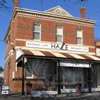
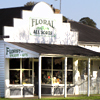

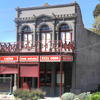
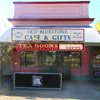
Learmonth Street shops
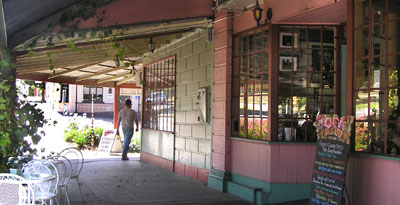
Original timbered shopfronts with wide shady verandahs in Learmonth St
Warrenheip Street shops
401 Warrenheip Street (next to the Bank)
This historically and architecturally important homemade brick building with adzed timber floors was built in the early 1860s for George Whykes' Grocery and Farm Produce Store. It has a cellar used for cool-storing milk, butter, cheese and eggs. The shop was closed in the 1960s then reopened in 1975 by Michael and Pat Whiteside who ran the Boninyong Market there, selling tea towels, flowers and secondhand furniture. It later operated as the Persimmon Tea-rooms until 1980 then Susie McKay opened an upmarket and innovative restaurant, Steptoes, that gained a statewide reputation for fine dining. In 1986 an old mine tunnel collapsed about 25 feet underground, undermining the south wall and requiring extensive repairs. In 1989, the adjoining Old Tin Shed was pulled down (also the 1856 weatherboard house on the north side) and the building became derelict after Susie wound up Steptoes in 1990. In recent years it has operated as a garden supplies/homewares shop.
Middleton's Ironmongery and Garage
One of the few weatherboard shops still standing and still used, this shop on the corner of Eyre and Warrenheip Streets was built around 1873 and for many years was known as Middleton’s ironmongery. In the 1920s the first petrol bowser in Buninyong, seen in the photo below, was erected on the footpath. Since then it has had many different uses: as a second-hand clothing shop, saddlery, antiques store, florist, mortgage broker, and more recently as a real estate office. 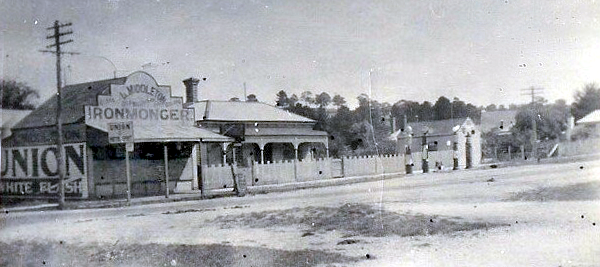
- Details
Historic Places
The Wathaurrung people gave Buninyong its name and its history has been written in several places.
The Keyeet balug clan of the Wada Wurrung (or Wathaurong) tribe first occupied the Mount Buninyong area and an aboriginal burial site was located in the 1860s. More recently, stone tools have been found but a full archaeological survey has not yet been conducted.
The first recorded ascent of its summit by European colonisers in 1837 led to the first squatting runs being taken up in the district in 1838, and then to the establishment of the township of Buninyong in 1841.
Mount Innes (formerly known as Hastie's Hill) and the nearby Hastie's Spring commemorate the work of Rev Thomas Hastie, the first Presbyterian minister in the region in 1847 who opened the first inland boarding school there soon after. Today, Hastie's Hill has several interesting examples of original drystone rock walls.
In the township itself, an early Burial Ground was established in the 1840s then replaced by the current cemetery in the 1850's.
In August 1851 the small village of Buninyong was transformed by the announcement of gold found by the local blacksmith, Thomas Hiscock. The site of this momentous discovery is marked today by a plaque in Hiscock's Gully Road. Buninyong became the early centre of the goldfields administration and embarked on an era of growth.
Buninyong's Botanic Gardens (pictured above) were laid out in the 1870's and the mature plantings with the rotunda built in 1901 to commemorate the reign of Queen Victoria, create a picturesque oasis today.
Lal Lal Falls and Blast Furnace
The Falls and Blast Furnace at Lal Lal are both of exceptional historic interest. The blast furnace represents the only attempt to smelt iron ore in Victoria and is believed to be only example in the Southern Hemisphere remaining from the nineteenth century. It has an ‘A’ classification from the National Trust. See Lal Lal Blast Furnace for more information.
The Lal Lal Falls, situated within the traditional country of the Wathawurrung people, is one of Victoria's most significant Indigenous cultural sites, as it is one of several recorded living sites of Bundjil- the Kulin peoples' creator spirit. Lal Lal Falls (later) ... became a tourism attraction for non-Indigenous Australians for its natural and cultural values.(Clark, Ian D., The Ebb and Flow of Tourism at Lal Lal Falls, Victoria: A Tourism History of a Sacred Aboriginal Site, Australian Aboriginal Studies)
- Details


















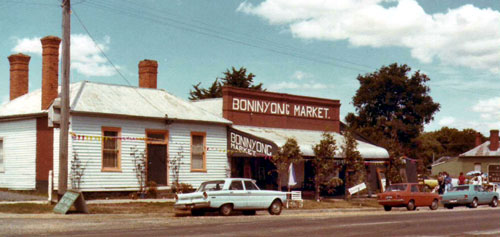 The south-east corner of Eyre and Warrenheip Streets in the late 1970's, before the Bank and new Post Office were built. (Photo by Michael Whiteside)
The south-east corner of Eyre and Warrenheip Streets in the late 1970's, before the Bank and new Post Office were built. (Photo by Michael Whiteside)